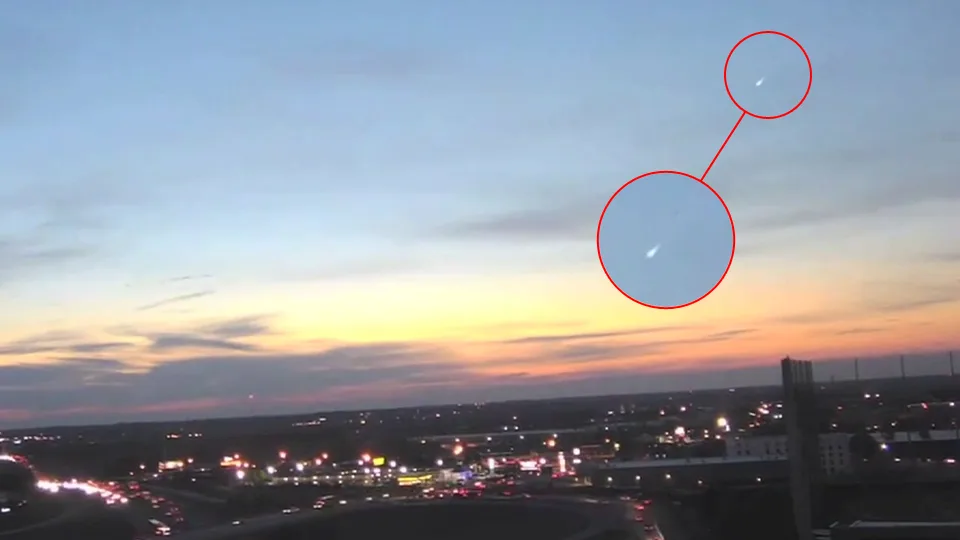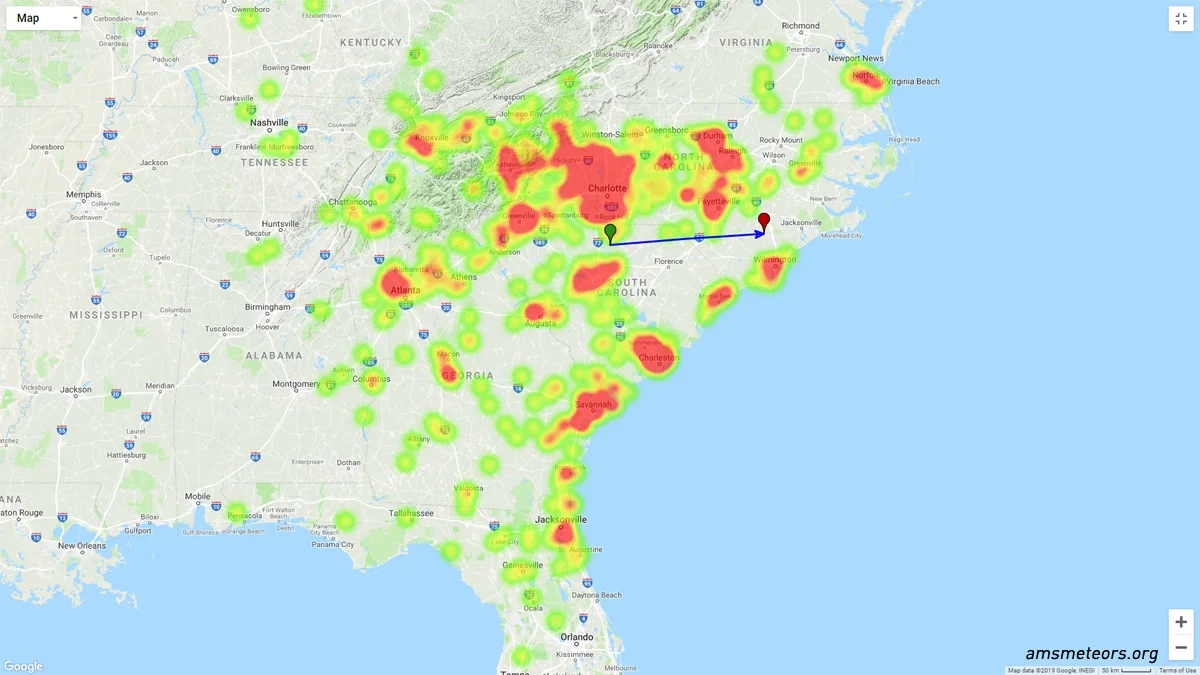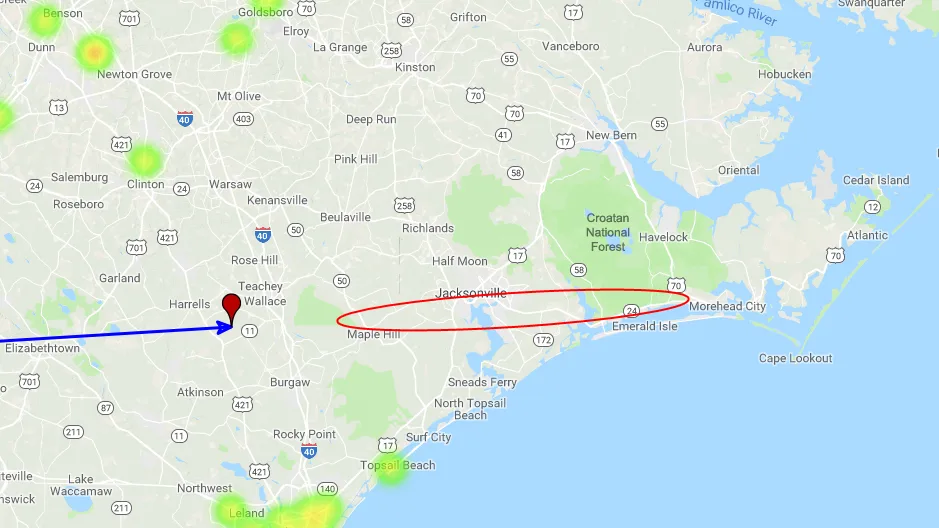
Daytime fireball blazes across the sky over the Carolinas
A brilliant daytime fireball turned heads across the southeastern U.S. on Thursday.
Early in the morning, on Thursday, April 4, early risers across the southeastern United States were treated to a spectacular sight.
A bright fireball meteor streaked and flared as it traced a long path across the pre-dawn sky!
As of Friday morning, the American Meteor Society had received over 800 reports of the meteor, mainly from observers concentrated in North Carolina, South Carolina and Georgia. Witnesses from as far away as central Florida, northern Kentucky, and even Andover, New Jersey also reported in.

This 'heat map' from the American Meteor Society uses colors to represent the density of reports. The arrow shows the estimated trajectory of the meteor, based on the reports provided by observers. Credit: AMSmeteors.org
WHAT HAPPENED HERE?
On any particular day, up to 300 metric tons of dust, rock and ice (collectively called 'meteoroids') is swept up from space by Earth's atmosphere, as the planet travels around the Sun.
A meteor is a flash of light produced as one of these meteoroids, travelling at speeds of anywhere from 40,000 km/h to 260,000 km/h, plunges into the upper levels of the atmosphere.
The force of the meteoroid pushing against the air molecules in its path compresses those molecules so much that they glow, and the extreme heat generated by the compressed air - up to 2,000 degrees Kelvin - vaporizes smaller meteoroids, such as dust and ice crystals. These make a brief flash in the sky before they're gone.
For larger ones, the heat scorches the outside of the meteoroid, and even burns away parts of it, causing the sputtering and flaring that this meteor demonstrated.
This particular meteor, since it was so bright, is known as a 'fireball'.
Professor Peter Brown, of the University of Western Ontario's Western Meteor Physics Group, said in an email to The Weather Network that the meteoroid may have been the size of a beachball or a small chair.
He acknowledged, though, that it is difficult to tell the size and mass of a meteoroid, simply from videos of the fireball.
While some meteors and fireballs are associated with regular 'meteor showers' that occur throughout the year, there are no major meteor showers occurring at this time. The next one that occurs is the Lyrid meteor shower, which is active each year between April 16-28, and peaks on the night of April 22-23 this year.
Since this fireball occurred outside of any regular meteor shower, scientists refer to these as a 'sporatic' - just a random meteoroid that our planet happened to encounter on its travels around the Sun.
HIGHLY VISIBLE
The timing of this fireball was fortunate, as so many people were up and getting out to start their day, and thus it generated over 800 reports so far (and very likely there were many more witnesses - potentially thousands - who did not report it).
What really made it stand out, according to Prof. Brown, was its long duration, which was due to the very shallow angle of its entry into the atmosphere.
"That, I think, is why so many people saw it, and why it was visible over such a large area," he said.

This 3D trajectory map shows how the meteoroid was angled downward as it travelled from west to east. Credit: AMS
This particular fireball was - perhaps - a little unusual, based on its direction of travel.
Meteor trajectories through the atmosphere should be fairly random, with just as many travelling east-to-west as there are west-to-east. After all, if this west-to-east meteoroid had been delayed by roughly seven minutes, it would have plunged into the atmosphere on the opposite side of Earth, probably over western China, travelling east-to-west.
Even so, the majority of fireballs reported on the AMS site appear to have an east-to-west trajectory, with fewer showing the west-to-east direction that this one took.
One fireball of note, from April 13, 2017, was also travelled from west to east, and coincidentally was also over South Carolina. Another, from October 7, 2016, was another long-track fireball, which travelled west to east, passing over the Great Lakes region. Most others reported on the AMS site are east to west.
This tendancy for east-to-west reports could easily be a trick of the angle that the meteoroid entered the atmosphere, however, along with a lack of anything to compare it to, in the sky, to get the proper perspective.
The meteor that exploded over Cuba, back in early February, is an excellent example.
Although most reports, and even the videos showing it, indicated that it was travelling northeast to southwest, data collected from a geostationary weather satellite told a different story. According to that data, the meteoroid entered the atmosphere on a trajectory almost straight down!
COULD THERE BE METEORITES?
It is quite possible that something survived from this fireball to reach the surface.
That means that there could be meteorites!

A close-up of the Heat Map shows the end of the fireball trajectory, and a very rough guess at where meteorites could have fallen, if something did survive. Credit: AMS/Scott Sutherland
Unfortunately, as the maps of the meteorite trajectory show, it was headed straight for the Carolina coast.
Fireballs like this one tend to flash across the sky starting at around 100 kilometres above the ground, and go 'dark' at about 40-50 km above the ground. After they go dark, anything left over takes on a simple ballistic trajectory... the same as if you released a rock into the air while flying in a plane. It continues along in the same direction, and arcs downward until it reaches the ground. If it's high enough in the air, it can still travel a far distance before it hits.
Given the meteor trajectory, and the distance it covered while it was visible, meteorite hunters would be well-advised to check doppler radar scans from Jacksonville, NC, to see if anything fell in that area, or possibly in the southern end of Croatan National Forest.
This one could easily have fallen into the Atlantic Ocean, off the Carolina coast, though.
Source: American Meteor Society
